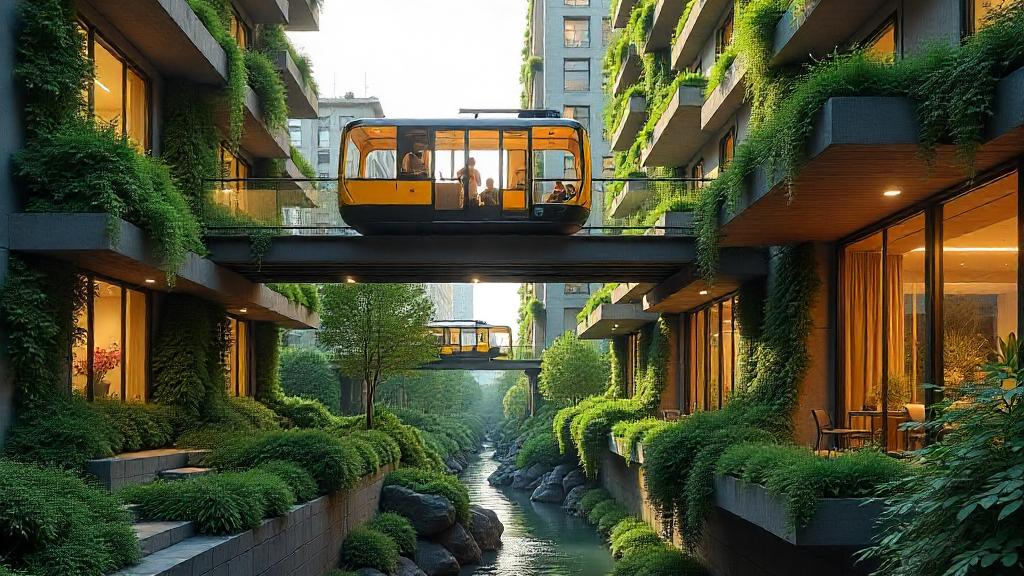

Today I look forward to socializing with friends at a suburb 50 km (31 miles) away. Love any excuse to journey in a podcar! I step out of my apartment and opt to take the moving walkway (also known as a travelator, walkalator, autowalk) to the Podcar station. It will only take 10 minutes to walk on the main non-moving pedestrian track. But my knee joints are a little fragile today. The moving walkway is at the entrance of my apartment and links other residences in the neighbourhood.
Malaysian-based journalist, Jennifer Rodrigo describes her journey in a podcar from her podcarcity suburb.
“Good morning Ma’am” greets Jacob, the walkway guide with the friendly face (and just so you know, he’s human). He is one of many guides along the moving track who help, support, answer questions, assist those with disabilities and guide everyone with online facilitation if needed. I call him my earth angel and I am gratified that the town council has provided such valuable employment in this way. Along the non-moving track, I see joggers, walkers and those heading for work. Cycling trishaws are back in business offering another transportation choice (and yes more employment opportunities here). No motorized vehicles are allowed on this people track and cyclists have their own lane.
I reach my station in less than 5 minutes and decide to take a solo Meditation pod and pay for that, costs a little more than the General Pod. The Meditation Pod can take up to 4 people but I pay a small premium for the solo journey. It would take 30 minutes to my destination, just enough time for calming meditation music and commentary which I choose from the Pod screen. There are a few options of Podcars offering public and privatized mobility. The Meeting Podcar where a work meeting can take place in the pod on the way to the office location. The General Podcar for commuters heading to the main city centre. A few kids with their families scramble into The Tourist Podcar for a fun ride. School kids and teachers find their way into the School Pod. The station is busy but no one seems to be rushing. Perhaps it is because they all know they do not have to deal with driving, traffic jams and where-to-park the car stresses.
Because the podcar is elevated, I get to enjoy the views of the urban regenerated suburb with its rooftop gardens, vertical forest buildings powered by solar and wind turbines. Edible gardens on the ground that were once roads, highways and car parks provide free plant food to anyone needing some and are constantly nurtured by volunteers and gardeners (yes, more employment). Rewilded natural landscapes with lush tree cover and waterfalls soothe the eyes and provide even more necessary oxygen. I am delighted to see the equatorial Flame of the Forest in glorious full bloom. Everywhere bougainvilleas in kaleidoscopic brilliance light up the landscape – it’s like a moving Van Goghesque masterpiece. Squirrels, tree shrews, rabbits, birds (just saw two hornbills fly past!) are also part of this world. Water fountains and waterfalls are everywhere. My pod passes this smart citiscape with its integration of eco-friendly architecture within an urban environment powered by renewable energy – solar, wind, hydrogen, geothermal and more.
I reach my destination and stop by the recycling centre to drop off a few things I don’t need. Later my friends and I go vegan food shopping and stop by the ‘Back to Earth” plot where we do a little planting – always good to feel the earth in your hands. After a thoroughly enjoyable time I bid my friends goodbye and decide to take the Cafe Pod for my return journey and a snack and drink along the way. When I arrive home, I grab a trolley for my groceries and use the moving walkway to my apartment. Life is good.
All some futuristic dream? No, “Personal Rapid Transit” (PRT) systems are already happening around the world in various transitional stages of sustainable green mobility.
“Personal Rapid Transit” (PRT) has many other names: “Group Rapid Transit” (GRT), “People Mover.” An updated term would be “Automated Transit Network” (ATN). An apt (and friendlier) description of this form of transport is “pod” – a term created by Swedish entrepreneur, Christer Lindstrom in 2000.
This is a public transport system featuring a network of specially built guideways on which ride fully automated vehicles (driverless) that provide on-demand transportation direct to your destination, no stops. They can be powered by solar, wind, biomass, geothermal, hydrogen energy, electricity and are already in existence in the United States, Sweden, U.K., France, Japan, China.
The following are some past, present and future pod car projects around the world:
1. One of the oldest and most extensive PRT systems currently operational is in Morgantown, West Virginia implemented since 1975.
2. Since 2010 a 10-vehicle 2getthere system has operated at Masdar City, Abu Dhabi.
3. Since 2011 a 21-vehicle Ultra PRT system – Heathrow Express – has serviced London Heathrow Airport.
4. A 40-vehicle Vectus system with in-line stations officially opened in Suncheon, South Korea, in April 2014.
5. A PRT system using pods to transport passengers connects the terminals and parking at the new Chengdu Tianfu International Airport, China which opened in 2021.
Senior PCC team member and INIST founder, Ron Swenson said this recently on LinkedIn: “Futran (under the Indian brand Nutran) is moving forward with its test track in Gujarat. The State Government of Maharashtra (where Mumbai is the main capital city) has shown keen interest as well.”
Based on latest reports and set to be completed in three years, Mumbai’s pod taxi project will run 21 pod taxis along a 3.9-kilometer route.